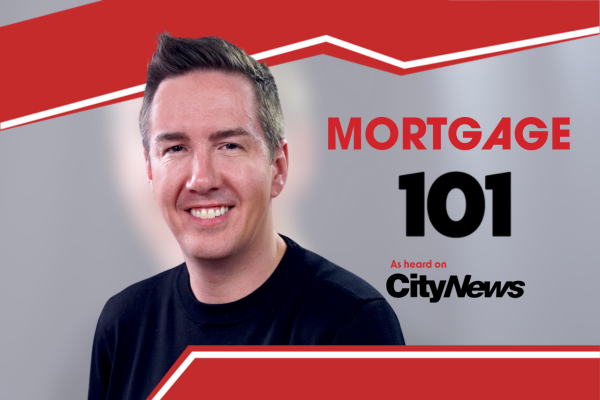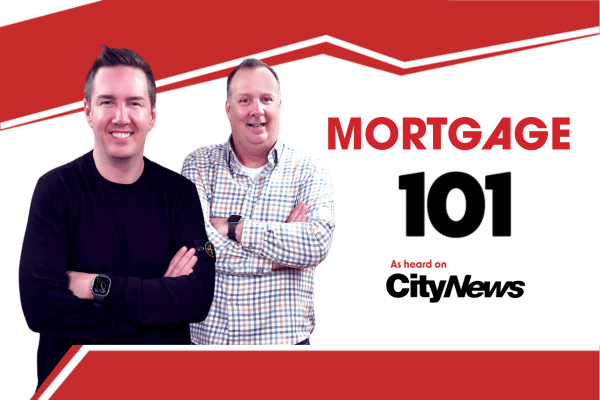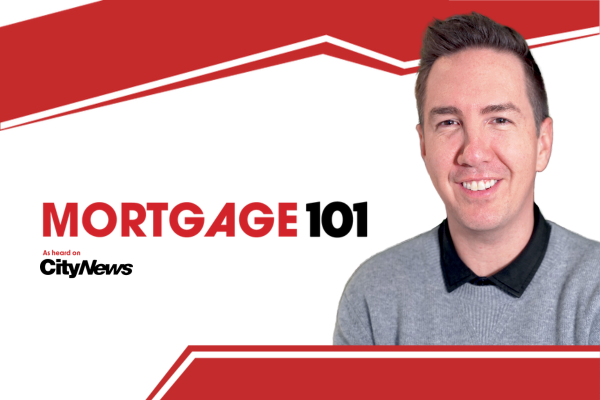What are the implications of the 30-year mortgage? Clinton and Todd sit down this episode and chat a bit more in-depth about what the 30-year mortgage means for first time homebuyers, noting the need for affordable housing options in the region, especially in urban centers like Halifax. Clinton emphasizes the importance of builders offering spec homes to cater to first-time buyers, advocating for standardized, cost-effective builds to reduce market competition and stress for buyers.
Mortgage 101 – want to lock in with a fixed rate? It will cost you | March 2022 Part 2
In this episode of Mortgage 101 with Clinton Wilkins and Todd Veinotte, as heard on CityNews 95.7, the guys talk about the Bank of Canada’s increases to the key overnight rate and what that means for your mortgage. Clinton elaborates on why the Bank of Canada increased the rate and talks about the differences between a fixed rate and a variable rate in 2022. The takeaway: If you want to lock in with a fixed rate, it will cost you.
Mortgage 101 with Clinton Wilkins & Todd Veinotte: Want to lock in with a fixed rate? It will cost you
Don’t feel like watching the video? Check out the transcript below.
Transcript:
We live answer calls in the office
Clinton Wilkins: [00:00:00:01] We certainly do have a great team behind us. And the one thing that I pride myself on, we actually answer the phone. You won’t be able to get us here on the weekend, but you know, during the day we try to answer every call that we can.
You know, obviously, we have an auto attendant just like every business. So, you know, if we can’t answer, then you know, you can still ring through to who you need to talk to. But we strive to live answer the telephone.
Bank of Canada rate increase takeaways
Todd Veinotte: [00:00:25:16] Yeah. Good. All right, let’s talk about the Bank of Canada. For the first time in a very, very long time, you and I chatted about this on my radio show on CityNews 95.7 the day that the Bank of Canada, well, we do this every time, the Bank of Canada announcement, that’s when you joined me on the show. But they raised the rate just ever so slightly. What was your general takeaway on that?
Clinton Wilkins: [00:00:46:01] You know what, I think economists have been saying for a while that the Bank of Canada is going to increase this key overnight rate. You know, they were speculating there might have been increases last year and then in January they were going to increase it. So no one was surprised when there was an increase. And they needed to, to stay the inflation.
Inflation is above target
As you know, right now, in Canada were suffering from, you know, high inflation. The inflation is above the target. We’re seeing that in gas prices. I mentioned that we’re seeing this even when you’re buying chicken breasts and things like that. So, you know, part of the reason that we’re seeing this high inflation, Todd, is people were home for two years. They weren’t shopping. They weren’t buying things, you know, they were maybe renovating their homes, but they were stockpiling cash, basically.
Now that things are reopening consumers are out in the market and they’re buying things, which is creating some supply chain issues. And it’s, you know, inflation is really tied to that supply and demand and the demand in the market is higher than the supply is for a lot of things. And that’s driving obviously up the inflation.
And one of the levers that the Bank of Canada, and really the federal government, has is to increase this key overnight rate and that will help stay the inflation. Some economists are projecting that we’re going to be at the target inflation by the end of the year, which I think is good news. You know, obviously we don’t know what’s going to happen.
Predictions are inflation will be back to normal by the end of 2022
Todd Veinotte: [00:02:12:26] So again, they’re predicting what?
Clinton Wilkins: [00:02:14:11] That the inflation is going to be at target.
Todd Veinotte: [00:02:17:01] Which is what? What’s the target?
Clinton Wilkins: [00:02:18:22] Well, they set a threshold where they want the inflation to be. So I think, you know, normally inflation somewhere like three per cent, let’s say.
Todd Veinotte: [00:02:25:09] Yeah.
Clinton Wilkins: [00:02:26:13] And that’s basically where the government wants to have the inflation. And right now we’re at historic highs in terms of inflation. So they increase the overnight rate by 25 basis points so that’s 0.25, and obviously that that directly impacted the prime rate. With most lenders, prime rate is now 2.70 per cent.
Okay, when the Bank of Canada increases the key overnight rate, typically what happens: Canadians start saving money. It’s just a symptom of a higher borrowing cost. And that’s really what the government is trying to do. In Halifax, you know, our gas prices are near the two dollars a litre mark.
How much more will my mortgage be now?
Todd Veinotte: [00:03:09:26] Maybe over that as well soon.
Clinton Wilkins: [00:03:11:26] And in some areas around the world, obviously it’s much more than two dollars a litre. You know, our point 0.25 increase in the key overnight rate is not insignificant. Obviously, it has an impact. If you have a variable rate mortgage, on average, your payments are going to increase about $12.50 or so per $100,000 mortgage.
Now obviously, things like amortization makes a difference, so I’m using just like a very general oversight. And a lot of borrowers are asking: Does it make sense to convert into a fixed rate? And the majority of them were saying, no, it doesn’t make sense. The fixed rates today for an equivalent product for most borrowers are going to be double what they’re paying in the variable.
There is a lot of runway between where the variable rates are and where the fixed rates are. So usually what we’re telling people is to weather the storm. Our average mortgage here is somewhere around $300,000, you know, in Halifax. And so that means the average consumer is seeing about a $35 increase in their mortgage payment based on this increase.
There’s going to be more, you know, the prime rate is going to continue to increase as the Bank of Canada tries to stay this inflation. And the thing is the prime rate has been lower and it may go down again.
Fixed rate or variable rates in 2022
There’s a lot of uncertainty of obviously what’s going on, what’s going on with Ukraine. It’s going to have an impact on global markets. So I think if you’re in a in a variable, you need to stay the stay the course.
Todd Veinotte: [00:04:47:17] But locking in. let’s say let’s suggest you’re in a variable and somebody says, “Look, Clinton, I want to lock it in.” What would the difference probably be at this point between the variable and the fixed?
Clinton Wilkins: [00:04:57:15] Depends on what your mortgage amount is. But I would say on average, it’s going to be like $200-$300 a month more to take a fixed rate.
Todd Veinotte: [00:05:04:02] Wow.
Clinton Wilkins: [00:05:04:24] And here’s the thing: You’re going to pay a higher rate for stability. Does it make sense to pay that much more just to know what you’re paying? Historically, borrowers do better in a variable, Todd.
Todd Veinotte: [00:05:18:14] Yeah.
Clinton Wilkins: [00:05:18:14] Historically, they do. You need to weather the storm. And you know, for us, obviously our clients, we’re doing a lot of communication with them. I put out a post on the Tuesday night before the Bank of Canada obviously made the announcement.
The writing was on the wall, so I basically told them what to prepare themselves with. Then obviously, we did a live stream right after the Bank of Canada met, and we emailed all our clients that were in a variable as well as business partners to let them know what happened. And we were actually able to get the message out even before Apple News got the message out. So we’re right all over it.
We sent an SMS out to all our clients that are in a variable that obviously have opted in to receive SMS. We can send them a quick message.
Todd Veinotte: [00:05:55:25] I receive it.
Clinton Wilkins: [00:05:56:14] Which is pretty cool, right? And these are next level things that maybe the bank cannot do. Like we’re small enough and nimble enough that we can do things like that, which I think is really cool.
Want to lock in with a fixed rate? It will cost you.
Todd Veinotte: [00:06:05:09] But there are some people that are willing to pay that premium, and I’m sure you talk to them. They say, “Look, I want a fixed rate,” and that’s fine, right?
Clinton Wilkins: [00:06:15:14] You know what? It is personal preference. I do not live in your household, and I think if you are losing sleep at night maybe having a fixed rate is not a terrible idea. You’re going to pay for it. It’s going to be a costly, you know, stability thing. But if it’s impacting you and your sleep, lock it in. It’s going to cost you and it’s going to be more expensive and there’s, you know, obviously some downsides from having a fixed rate, but you know, there are some upsides too.
The one thing that I do want to caution listeners with: If you were going to convert now instead of weathering the storm in the variable rate, what happens if these fixed rates go back down? You could pay a very large penalty if you need to break your mortgage early, and Canadians are notorious at breaking their mortgage before the term is up.
Todd Veinotte: [00:07:06:17] Yeah, why do you say that?
Canadians break mortgages early
Clinton Wilkins: [00:07:08:21] You know life changes, right? The average mortgage in Canada is a five year term. So many borrowers break their mortgage before the five year term. Maybe they’re buying, they’re selling. They could be doing a refinance. There’s a lot of reasons why people break their mortgages early. One of the big reasons right now existing home owners are breaking their mortgage early is because values are up and rates are pretty low, right? So they have the ability to refinance and pull that equity out. And maybe they’re going to pay down some debt. Or maybe they are going to, you know, do some investments, or maybe they’re going to do some renovations on their home so we can maybe talk a little bit about that too.
Next up: Refinance
Todd Veinotte: [00:07:49:15] Yeah, we can talk about refinance. There’s all types of parts, variables concerning a refinance, for sure. So let’s do that. And what else do you want to talk about in the show today?
Clinton Wilkins: [00:07:59:17] We’re going to talk obviously about what’s going on here in the housing market. You know, obviously we’re coming into spring. It’s one of the busiest seasons of the year for obviously buying and selling homes, so we’ll certainly talk more about that during the show.
Todd Veinotte: [00:08:17:18] Ok, so this is, you having a good time, though, aren’t you?
Clinton Wilkins: [00:08:21:02] Oh yeah, I’m having a great, I’m having a great time.
Todd Veinotte: [00:08:23:05] This is one of the highlights of your whole month, isn’t it?
Clinton Wilkins: [00:08:25:01] It is, really. We get really excited about Mortgage 101. I just want to give a little quick shout out that the show is going to be available on Anchor and anywhere you want to listen to your podcast so you can listen to all our old shows there. It’s also going to be on social media and on our website, so you can certainly check out any of our old content as well.
Todd Veinotte: [00:08:42:14] Ok, Mortgage 101 Your Guide to Homeownership returns.
If you have any questions, get in touch with us at Clinton Wilkins Mortgage Team! You can call us at (902) 482-2770 or contact us here.


